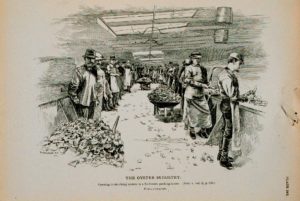Most people from oyster-producing regions like the Chesapeake can attest to the fact that oysters are important the the social fabric of the community. In many towns that date back to the colonial era, oyster shells literally line Main Street and form the foundation of the town. In others, they form the basis of a modern-day bar scene boasting of “merroir” of the oysters alongside terroir of the wine. When the ecosystem around these kinds of places changes (think warming waters, acidified waters, introduced species who also love oysters), the resource underpinning this aspect of culture and heritage can be threatened. What does that mean for the humans so connected to the briny bivalve?

A new paper by myself, Bruce Vogt, and Troy Hartley proposes we monitor that connection to oysters alongside the more standard indicators like water quality, benthic community, and oyster population. This kind of monitoring is important in efforts to expand fisheries management to an ecosystem perspective and also potentially gives community members yet another reason to care when their local water body receive a grade of “C”. Given monitoring of this kind is often completed on a shoestring budget and must integrate well with existing monitoring data, there’s some serious restrictions about what kind of information can fill this void. But the paper gives us an elegant solution: business names taken from state tax records.
Turns out, there’s a cadre of people who aren’t trying to sell actual oysters who name their auto repair shops, wineries, and antique shops after oysters to pay homage to the historical creature. According to business owners, there’s a desire to directly credit the region’s identity in part to oysters.
Of course, there’s other kinds of value associated with oysters – namely, they’re delicious and people are willing to support a fishing industry (both wild and mariculture, in the Chesapeake) in order to eat them. Small towns and neighborhoods are also named after historical oyster industry areas or large oyster bars in credit to the prominence they carry in the community. So the bottom line is that oysters represent many kinds of cultural value to the people of the Chesapeake, and this is something worth monitoring and preserving.
But don’t just take my word for it – read the paper! It’s open access for the first 50 days of publication on Ecological Complexity’s website, and after that, don’t hesitate to ask me for a copy!